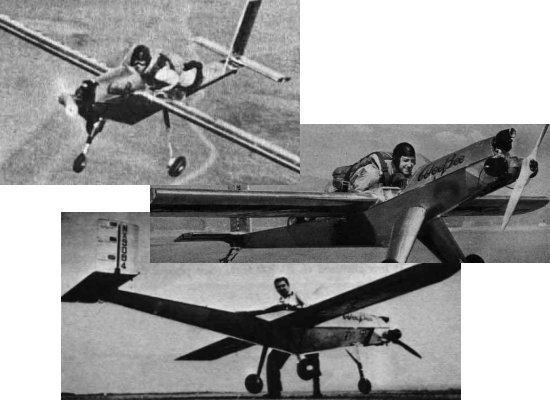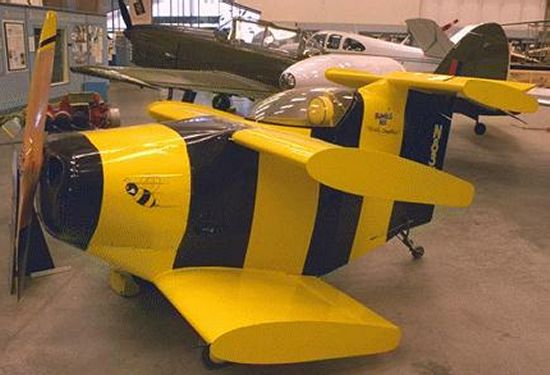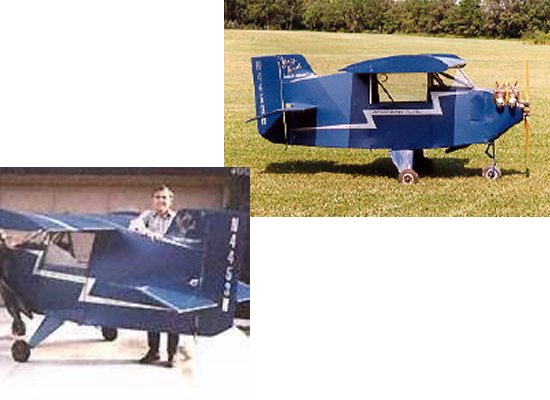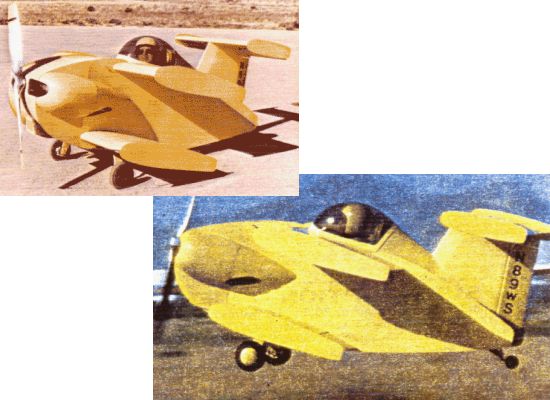|
||||||||||
|
|
||||||||||
|
||||||||||
|
|
||||||||||
However, we will assume that this question is asking about the smallest manned plane in the world, or the smallest plane flown with a human pilot aboard. Even this category can be confusing since it could possibly include vehicles like hang gliders or ultralights, but we will limit our discussion to more conventional airplane types. This definition leaves us with three primary sets of aircraft designers who have competed against each other to build and fly the "world's smallest plane" since the end of World War II.
The first plane to be so titled was known as the Wee Bee. The diminutive plane was designed, built, and flown by Ken Coward, William Chana, and Karl Montijo in San Diego, California, during the late 1940s. Just over 14 ft (4.25 m) long and with a wingspan of only 18 ft (5.5 m), the Wee Bee was powered by a 30-hp piston engine and could carry a maximum of 200 lb (90 kg), including the pilot and fuel. Weight was kept to a minimum by having the pilot lay in a prone position atop the fuselage.

Only one example of the unusual Wee Bee was built, making its first flight in 1948. The Wee Bee was later placed on display at the San Diego Aerospace Museum but was lost in a fire that swept through the museum in 1978. A replica has now taken the place of the destroyed original. The creators of the Wee Bee also formed a small company called Bee Aviation, or Beecraft, that went on to build a larger version called the Honey Bee. With a wingspan of 28 ft (9.5 m), the Honey Bee could carry a single pilot in a more comfortable and conventional seated position.
Following in the footsteps of the Wee Bee was an even smaller plane called the Stits Junior. Designed by Ray Stits and Martin Youngs, the Junior was rebuilt from the components of a surplus World War II Taylorcraft L-2. The Junior was around 11 ft (3.4 m) in length and had a wingspan that varied between 8.8 and 9.3 ft (2.7 to 2.8 m) over the course of three different modifications. Power was provided by a single piston engine ranging from 36 to 75-hp that gave the Junior a top speed up to 150 mph (240 km/h).

Also competing against Stits to build the world's smallest plane during the 1940s was Wilbur Staib, an engineer living near Los Angeles. Believing he could build a plane even smaller than the Junior, Staib set out to design and build a tiny monoplane called the Little Bit. Only 11 ft (3.4 m) long and with a wingspan of just 7.5 ft (2.3 m), the Little Bit weighed a mere 390 lb (177 kg) empty. Unfortunately, the plane was never successfully flown and was dismantled as a "hazard to the life and limb of Wilbur Staib." The parts of the Little Bit were later reused in a biplane with a 13 ft (4 m) wingspan.
However, Staib's challenge only encouraged Stits and co-builder Robert Starr to build a new plane even smaller than the Junior or the Little Bit. Known as the Sky Baby, this new plane differed from earlier entries into the arena by adopting a biplane design instead of a monoplane. This change allowed the wingspan to be reduced even further to just over 7 ft (2.1 m). With a maximum length under 10 ft (3 m), the Sky Baby weighed just 452 lb (205 kg) empty and 666 lb (302 kg) fully loaded. Its 65-hp piston engine gave the Sky Baby a maximum speed of 185 mph (300 km/h). Pilot Robert Starr flew the Sky Baby at air shows from April to November of 1952, and the plane was donated to the National Air and Space Museum in 1972. The Sky Baby is currently exhibited at the Experimental Aviation Association AirVenture Museum in Oshkosh, Wisconsin.

The Sky Baby remained unchallenged as the world's smallest plane until the 1980s when its former pilot, Robert Starr of Phoenix, Arizona, built the Bumble Bee. The Bumble Bee biplane was heavier than the Sky Baby at 547 lb (248 kg) empty and 725 lb (329 kg) loaded. However, its dimensions were otherwise smaller with a length under 9.5 ft (2.9 m) and a wingspan of just 6.5 ft (2 m). As a result, the Guinness Book of World Records considered the Bumble Bee to be the smallest plane in the world following its first successful flight on 28 January 1984. Powered by an 85-hp piston engine, the Bumble Bee was capable of 180 mph (290 km/h).

Not to be outdone, Ray Stits' son Donald set out to recapture the title by building an even smaller monoplane called the Baby Bird. At 11 ft (3.4 m) in length, the Baby Bird was longer than the Bumble Bee but had a smaller wingspan of 6.25 ft (1.9 m) and weighed less at only 250 lb (115 kg) empty. Its 55-hp piston engine gave the Baby Bird a maximum speed of 110 mph (175 km/h) when it first flew at Camarillo, California, on 4 August 1984. Pilot Harold Nemer completed 35 flights aboard the Baby Bird by the time it was retired in 1989.

However, Robert Starr believed he could go even smaller and completed a new Bumble Bee II in 1988. Though still heavier than the Baby Bird with an empty weight of 396 lb (180 kg), the overall dimensions of the Bumble Bee shrank even further to 8.8 ft (2.7 m) in length and a mere 5.5 ft (1.7 m) wingspan. Its 85-hp piston engine made possible a maximum speed of 190 mph (305 km/h).

Unfortunately, the first flights of the Bumble Bee II on 8 May 1988 proved a mixed success. Starr was able to make several passes over the airfield demonstrating the plane could fly and earning his place in the record books, but the attempt nearly cost Starr his life. While at an altitude of about 400 ft (120 m), the Bumble Bee II suffered an engine failure and fell from the sky. The plane was completely destroyed in a crash that left Starr seriously injured, though he later made a full recovery.
| Comparison of Several of the World's Smallest Planes | |||||||
|---|---|---|---|---|---|---|---|
| Builder | Plane | Length | Wingspan | Empty Wt | MTOW | Propulsion | Max Speed |
| 14'2" | 18'0" | ? | ? | 30-hp Kiekhaefer | 82 mph | ||
| Stits | Junior | 10'10" to 11'4" | 8'10" to 9'4" | ? | ? | 75-hp Continental C-75 | 150 mph |
| Staib | 11'0" | 7'6" | 390 lb | ? | 85-hp Continental C-65 | ? | |
| Stits | 9'10" | 7'2" | 452 lb | 666 lb | 65-hp Continental C-65 | 185 mph | |
| Starr | 9'4" | 6'6" | 547 lb | 725 lb | 85-hp Continental C-85 | 180 mph | |
| Stits | 11'0" | 6'3" | 252 lb | ? | 55-hp Hirth | 110 mph | |
| Starr | 8'10" | 5'6" | 396 lb | ? | 85-hp Continental C-85 | 190 mph | |
Perhaps hoping to prevent further life-threatening crashes in this battle of the small, the Guinness Book decided to credit both Stits and Starr with world records. The Stits Baby Bird is considered the world's smallest monoplane while Starr's Bumble Bee II is the world's smallest biplane. Although the Bumble Bee II was tragically lost, the original Bumble Bee is on display at the Pima Air & Space Museum in Tucson, Arizona. Like his father's Sky Baby before it, Donald Stits' Baby Bird is also on display at the EAA AirVenture Museum.
As tiny as these planes were, they were all built of conventional construction materials like aluminum. Recent
advances in composite materials that provide the same strength as metals yet weigh far less may make it possible
for a future innovator to build an even lighter and smaller plane.
- answer by Molly Swanson, 6 February 2005
Related Topics:
Read More Articles:


|
Aircraft | Design | Ask Us | Shop | Search |

|
|
| About Us | Contact Us | Copyright © 1997-2023 | |||
|
|
|||